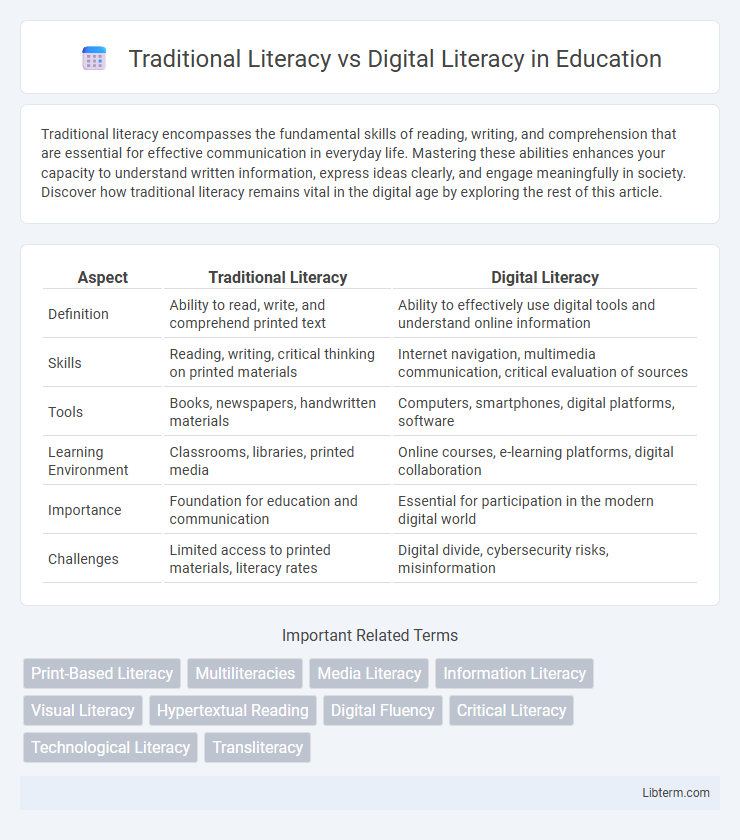Traditional literacy encompasses the fundamental skills of reading, writing, and comprehension that are essential for effective communication in everyday life. Mastering these abilities enhances your capacity to understand written information, express ideas clearly, and engage meaningfully in society. Discover how traditional literacy remains vital in the digital age by exploring the rest of this article.
Table of Comparison
| Aspect | Traditional Literacy | Digital Literacy |
|---|---|---|
| Definition | Ability to read, write, and comprehend printed text | Ability to effectively use digital tools and understand online information |
| Skills | Reading, writing, critical thinking on printed materials | Internet navigation, multimedia communication, critical evaluation of sources |
| Tools | Books, newspapers, handwritten materials | Computers, smartphones, digital platforms, software |
| Learning Environment | Classrooms, libraries, printed media | Online courses, e-learning platforms, digital collaboration |
| Importance | Foundation for education and communication | Essential for participation in the modern digital world |
| Challenges | Limited access to printed materials, literacy rates | Digital divide, cybersecurity risks, misinformation |
Understanding Traditional Literacy
Traditional literacy encompasses the ability to read, write, and comprehend printed texts, forming the foundation for effective communication and learning. It involves skills such as phonemic awareness, vocabulary development, and comprehension strategies essential for interpreting books, newspapers, and handwritten documents. Mastery of traditional literacy supports cognitive development and access to information across diverse academic and professional contexts.
Defining Digital Literacy
Digital literacy encompasses the ability to effectively find, evaluate, create, and communicate information using digital technologies, including computers, smartphones, and the internet. It involves critical thinking skills to navigate online content safely and responsibly, recognizing credible sources and avoiding misinformation. Unlike traditional literacy, which centers on reading and writing printed text, digital literacy requires proficiency in multimedia, digital tools, and understanding online social norms.
Key Skills in Traditional Literacy
Traditional literacy emphasizes foundational skills such as reading comprehension, writing proficiency, spelling accuracy, and grammar understanding. These skills enable effective communication and critical thinking through printed texts and handwritten materials. Mastery of traditional literacy forms the basis for academic success and everyday information processing before progressing to digital literacy competencies.
Essential Competencies in Digital Literacy
Essential competencies in digital literacy encompass critical thinking, effective communication, and proficient use of digital tools and platforms, contrasting with traditional literacy's focus on reading and writing skills. Mastery of online research techniques, understanding digital security, and media literacy remain crucial for navigating the digital landscape. These competencies empower individuals to evaluate information credibility, participate in digital collaboration, and adapt to evolving technological environments efficiently.
Historical Evolution of Literacy
Traditional literacy, rooted in ancient civilizations, emphasized the ability to read and write printed texts, forming the foundation of education and communication for centuries. With the advent of the digital age in the late 20th century, digital literacy emerged, expanding the concept to include skills in navigating, evaluating, and creating content through digital technologies and the internet. This evolution reflects a shift from solely decoding written language to mastering multimedia information and digital tools critical for participation in modern society.
The Impact of Technology on Reading and Writing
Digital literacy reshapes reading and writing by emphasizing skills in navigating, evaluating, and creating content across digital platforms, contrasting with traditional literacy's focus on print-based comprehension and handwriting. Technology introduces multimodal texts, such as hyperlinked documents, multimedia, and interactive content, requiring readers to develop critical thinking and adaptation to diverse formats. The integration of digital tools enhances collaborative writing and instant access to information, fundamentally transforming literacy practices and cognitive engagement with texts.
Comparing Educational Approaches
Traditional literacy emphasizes reading, writing, and comprehension skills developed mainly through print-based materials, fostering deep understanding and critical analysis. Digital literacy incorporates the ability to navigate, evaluate, and create content using digital technologies, promoting adaptability and multimedia communication competence. Educational approaches to these literacies differ, with traditional methods prioritizing textbook learning and handwriting, while digital literacy integrates interactive tools, online resources, and collaborative platforms to enhance engagement and real-world problem-solving.
Challenges in Teaching Literacy Today
Teaching literacy today faces challenges such as bridging the gap between traditional literacy skills, like reading and writing on paper, and digital literacy competencies including navigating online platforms and evaluating information credibility. Educators must address diverse student needs while integrating rapidly evolving technology tools and combating digital distractions that impede focus. Limited access to digital resources in some communities exacerbates educational inequities, making comprehensive literacy instruction more complex than ever.
Bridging the Gap Between Print and Digital Skills
Bridging the gap between traditional literacy and digital literacy requires integrating print reading and critical thinking skills with digital navigation, media evaluation, and information synthesis. Emphasizing multimodal learning strategies helps learners adapt to both print and digital contexts, enhancing comprehension and communication across platforms. Educators must foster digital fluency while preserving foundational print literacy to prepare individuals for the demands of a hybrid information environment.
Preparing for the Future of Literacy
Traditional literacy emphasizes reading and writing skills essential for understanding printed texts, while digital literacy encompasses the ability to navigate, evaluate, and create information using digital technologies. Preparing for the future of literacy involves integrating skills like critical thinking, media literacy, and digital communication to adapt to evolving information landscapes. Educational frameworks increasingly prioritize blending traditional and digital literacies to develop competent and versatile learners in a technology-driven world.
Traditional Literacy Infographic

 libterm.com
libterm.com